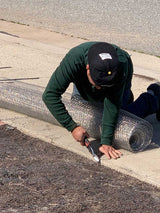Galvanized Chicken Wire
FREE SHIPPING
✅ Estimated Order Delivery Date: Apr 1 - Apr 2.
The galvanized chicken wire ships from our Utah warehouse.
FREE SHIPPING
✅ Estimated Order Delivery Date: Apr 1 - Apr 2.
The installation of Gopher Block® is straight forward and can be installed by a homeowner or landscape contractor.
Install Guide: Download PDF

Fast Shipping
(orders to California are delivered in approximately 2-3 business days)
Gopher Block® orders typically are shipped within 1 business day. Smaller orders (less than 5 rolls) ship via UPS/Fedex and larger orders ship LTL freight. If your delivery is by LTL freight, the freight company will call to schedule a delivery appointment.

Each roll of Gopher Block® requires 100 ground staples for proper installation. (sold separately).
Visit our Project Gallery to view a wide variety of different Gopher Block® installations by our customers.



Although Gopher Block® is not specifically designed to prevent mole intrusion, we have had customers that have installed it for this application and the gopher wire has proved effective at deterring moles from tunneling into landscape and lawn areas.
"After tilling and clearing the loam from our yard, I installed the gopher wire roll. I then applied another 6 inches of topsoil/compost and then laid 1,800 square feet of zeon zoysia sod. The gopher wire roll is an incredible product and in my mind worth every penny. I have already seen the results. There is an adjacent section where our yard meets the neighbors yard. Given the frequent watering/worms, etc. our yard has become an attractive site for moles. Well, our yard has been perfectly protected from the moles, and our neighbors yard is full of new holes and tunnels. They just cannot seem to penetrate the wire roll. The quality is also impressive. Does not even compare to the junk available at “unnamed big box” hardware store (trust me, I looked!) Anyway, here are several photos of the installation process and the final product. "
-
Colin R.
Austin, TX



As I'm sure you know, chicken wire fences were designed to keep chickens as well as other small animals and pets in a safe place away from predators. Today, many clever, creative people have found other ways to use chicken wire to enhance their gardens and backyards while adding a nice touch to your property. Also, chicken wire fence is very flexible and less expensive than chain link fences. Unlike wood, you can still enjoy great views beyond your backyard because it's very transparent. Chicken wire has become very popular throughout rural and urban areas alike. It's very affordable, easy to install, and will add a wonderful touch to your landscaping. Some people have created trellises for their gardens or around their landscaping adding a wonderful appeal.
Chicken wire is made from galvanized steel strands forming a mesh that was originally used to create chicken coops to keep chickens in their pens. You will find these fences in rural farm areas and has become very popular in other areas outside of farming communities. You will see chicken wire fencing for backyards, gardens, and even as a dog fence to keep your puppy safe. We will go over the ins and outs of creating a DIY chicken wire Fence and why this wire fencing has become so popular over the years?

Hens in Chicken Coop
If you can't wait to dive into DIY projects, you will find that chicken wire fencing has a lot of advantages over other fence materials including wood, metal, vinyl, and PVC materials due to its low cost and it's very easy to install on your own. These fences are excellent for keeping wild predators like raccoons out Chicken wire fences are better than wooden fences or chain link fences because they go underground and will keep animals from digging underneath to gain access to the pen. Also, a chicken wire fence will give you great curb appeal.
• Post hole digger
• Shovel
• Sledgehammer or post-driver
• Level
• Heavy-duty stapler
• Framing nails
• Wire cutters
• Hammer
• Metal or wooden posts
• Spray paint or stakes and twine
• Framing lumber - 2x3’s, 2x4’s, or 2x6’s cut to length
• Chicken wire mesh
• Poultry staples
• Zip ties
Now that you have your tools and materials, it's time to build a chicken wire fence or a garden fence. The following instructions will explain the steps for installing the fenceOutline the area of the fence using spray paint or the stakes and twine. Make sure the path is precisely marked so you can build the fence accurately.
When you are ready to install the posts, you have two options. Wooden or metal posts are known as U -Posts and T- Posts. You have to build a frame with framing lumber to attach to the posts once they are in place.
If you want wooden posts, you have to add top and bottom rails after the posts are in place. For T or U posts, you need a sledgehammer to drive them in place. For wooden posts, you need a post-hole digger or shovel to create the holes and then place the posts in the holes.
Install the posts in the spots you measured ahead of time as discussed in Step One. Make sure the holes are at least 6 inches deep. You can use dirt to fill the holes, you do not need concrete. Each post should be spaced evenly and not more than 10 feet apart.

Chicken Coop - Newly Built
This is for chicken wire fences to keep chickens or other small animals safe. This is where trenches come into play. Some animals will try to dig under the fence. The trench should go all the way around the path of the chicken fence and should be one foot deep between the posts.
Start working on the wooden frame to outline each section of the chicken wire fence. Lay out the framing lumber and then use the hammer and nails to construct the lumber and should be the same size as the area between the posts. The frame should be measured and built so its bottom edge will fit in the one-foot trench you created. If a trench is not needed, the wooden frame has to be measured in order to fit the distance between the posts but not make it taller because there won't be a trench.

Chicken Wire Rolls
Once the posts are in place and the trenches dug, you can stop by Home Depot or go to Amazon online to find out how many staples you are going to need. In the meantime, you can temporarily use zip ties to attach the wire mesh to the posts until you get the staples.
If you are creating a fence to keep chickens safe versus a structure for your yard or garden, the depth is critical to keep wildlife from digging underground. Once you have outlined the path of the fence and installed the posts, dig a trench approximately one foot deep from one post to another and repeat this step along the entire length of the fence. Take the wooden frame with the mesh attached to it and place it in the trench. Make sure the fence extends underground deep enough to keep other animals out.
Building a standard chicken wire fence will take approximately one or two days. If you are building a garden fence, it should only take a few hours to complete. The length of time for installing your fence will depend on the length of the fence and whether or not you will need a trench. If you need to install a gate, allow for additional time for the steps required to install the gate.
You probably should get someone to help you stretch and secure the mesh to the next post. Take the poultry staples to secure the steel wire to the top, center, and bottom of the first post then stretch the mesh to the next post using the staples or hammering them in place. This step must be repeated throughout the entire fence.
After you have installed the chicken wire mesh to the posts or wooden frames, you need to trim off any excess wire using wire cutters to remove any sharp points that can harm you and provide you with a neat and polished look. If you have never created and installed a chicken fence, you might have a few questions.
To carry this step out, all you need is a heavy-duty stapler or hammer along with plenty of staples. You have to staple the wire mesh three times to each post then along the top and bottom if you are using wooden frames. Before starting this process, make sure you have calculated everything you will need for the fence before heading out to your home improvement center, like the Home Depot.

Chicken Wire on Chicken Coop
As with any project, plan ahead of time, take into consideration each step and what you need to complete the process. Be sure you have all the tools and materials you will need to get it done correctly.
Creating and installing a chicken wire fence is not expensive and is very easy to install. Contact your local home garden center for more tips and tricks and follow their advice. If you are someone who likes DIY projects, this is for you.